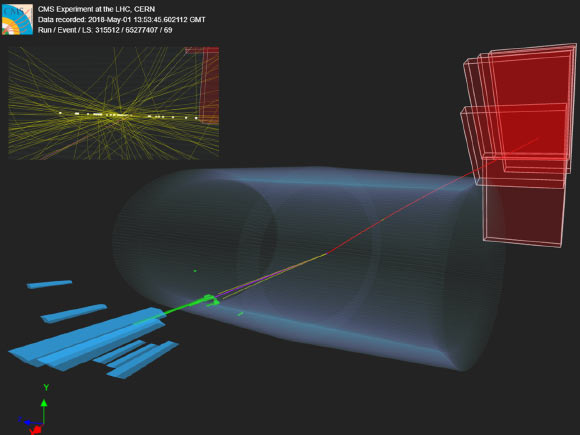According to physicists from the CMS Collaboration at CERN’s Large Hadron Collider (LHC), it is the first time that this process has been seen in proton-proton collisions. It is also the most precise measurement of the tau’s anomalous magnetic moment and offers a new way to constrain the existence of new physics.
Recreated candidate event of a γγ →ττ process in proton-proton collisions measured by the CMS detector. The tau can decay into a muon (red), charged pions (yellow) and neutrinos (not visible); energy deposits in the electromagnetic calorimeter in green and in the hadronic calorimeter in cyan. Image credit: CMS Collaboration.
The tau, sometimes called tauon, is a peculiar particle in the family of leptons.
In general, leptons, together with quarks, make up the matter content of the Standard Model.
The tau was only discovered in the 1970s and its associated neutrino — the tau neutrino — completed the tangible matter part upon its discovery in 2000 by the DONUT Collaboration at Fermilab.
Precise research for the tau is rather tricky though, as its lifetime is very short — it remains stable for only 290*10-15 seconds.
The two other charged leptons, the electron and the muon, are rather well studied.
A lot is also known about their magnetic moments and their associated anomalous magnetic moments.
The former can be understood as the strength and orientation of an imaginary bar magnet inside a particle.
This measurable quantity, however, needs corrections at the quantum level arising from virtual particles tugging at the magnetic moment, deviating it from the predicted value.
The quantum correction, referred to as anomalous magnetic moment, is of the order of 0.1%.
If the theoretical and experimental results disagree, then this anomalous magnetic moment, al, opens doors to physics beyond the Standard Model.
The anomalous magnetic moment of the electron is one of the most precisely known quantities in particle physics and agrees perfectly with the model.
Its muonic counterpart, on the other hand, is one of the most investigated ones, into which research is ongoing.
Although theory and experiments have mostly agreed so far, recent results give rise to a tension that requires further investigation.
For the tau, however, the race is still going. It is especially hard to measure its anomalous magnetic moment, aτ, due to the tau’s short lifetime.
The first attempts to measure aτ after the tau’s discovery came with an uncertainty that was 30 times higher than the size of the quantum corrections.
Experimental efforts at CERN improved the constraints, reducing the uncertainties to 20 times the size of the quantum corrections.
In collisions, physicists look for a special process: two photons interacting to produce two tau leptons, also called a di-tau pair, which then decay into muons, electrons, or charged pions, and neutrinos.
So far both ATLAS and CMS collaborations have observed this in ultra-peripheral lead-lead collisions.
Now, the CMS physicists report on the first observation of the same process during proton-proton collisions.
These collisions offer a higher sensitivity to physics beyond the Standard Model as new physics effects increase with the collision energy.
With the outstanding tracking capabilities of the CMS detector, the collaboration was able to isolate this specific process from others, by selecting events where the taus are produced without any other track within distances as small as 1 mm.
“This remarkable achievement of detecting ultra-peripheral proton-proton collisions sets the stage for many groundbreaking measurements of this kind with the CMS experiment,” said Dr. Michael Pitt, a member of the CMS team.
This new method offers a new way to constrain the tau anomalous magnetic moment, which the CMS Collaboration tried out immediately.
While the significance will be improved with future run data, their new measurement places the tightest constraints so far, with higher precision than ever before.
It reduces the uncertainty from the predictions down to only three times the size of the quantum corrections.
“It is truly exciting that we can finally narrow down some of the basic properties of the elusive tau lepton,” said CMS team member Dr. Izaak Neutelings.
“This analysis introduces a novel approach to probe tau g-2 and revitalises measurements that have remained stagnant for more than two decades,” said CMS team member Dr. Xuelong Qin.


